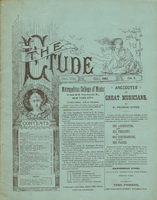BY WILLIAM E DOGGETT.
To be a good music teacher one should be a thorough musician, a just critic, something of an anatomist, a companion, master, and a gentleman. The companion should ever be a firm master, but the firm master should never cease to be a true gentleman.
The gaining of a good musical education requires such an expenditure of money, time and vitality, that the teacher should seek out for his pupils the most scientific and economical system of technic: economical particularly from the standpoint of time and vitality; all practice that is neutralizing in its effect, i. e., undoing of something that has already been done, duplicative or in any other way superfluous, should be rejected, and only those exercises and études taught that have a well defined purpose and will be of actual use to the student in his playing. Do not belong to that class of teachers who teach every pupil just as they were taught, who apply their instruction in a uniform patent process way, but try to minutely diagnose the case of each student and give him the precise treatment required.
The general course of training must necessarily be the same in all cases, but variations of temperament, hand defects, physical strength, aptitude, etc., will compel the teacher to vary his method, at least as to order, proportion, and amount of practice.
I do not believe five finger exercises are suitable for developing and maintaining a good technic; the fingers are of unequal strength, and if the same amount of practice could be given to each, though they would all be strengthened the ratio of inequality would remain unchanged; but on the contrary, owing to the natural arrangement of the strong and weak fingers, we are compelled, in five-finger exercises, to use the strong fingers more than the weak ones; third finger most, second and fourth next, and first and fifth least—a very unfavorable condition. In at least half of the examples given us, the weak fingers of one hand are used with the strong fingers of the other, and as we equalize the strength of one hand, we are very apt to disproportion that of the other. Nor do I believe five-finger exercises afford proper training for the extensor muscles. After a blow the finger is lifted sufficient to allow the key to rise, requiring one contraction of the extensor muscle; here it is held till the finger is to be used again, when the contraction is resumed and the finger raised to the height desired. Now, instead of these two distinct contractile efforts, one prompt, complete, and vigorous contraction would, I think, be far more beneficial.
These objections, and many others, are entirely obviated, or reduced to a minimum, in Mason’s two finger exercises from “Touch and Technic,” which, in my opinion, is the simplest, most scientific, economical, condensed, and yet exhaustive system ever presented to the public; containing, as it does, training for finger, hand, arm, foot, and, if taught to their full capacity, eye, ear, and important mental faculties.
The object of scale and arpeggio practice is not, as most pupils and teachers would say, using their own language, “to limber the fingers,” but to store the mind with tone forms or tonal words by which musical ideas are expressed and understood; to familiarize one with that material that goes to make up every piece of music. If teachers would impress on their pupils the fact that every piece, as they are familiarly called, is, after all, made up of fragments of finger exercises, scales, arpeggios, etc., joined together in a great variety of ways, and that while they are practicing these exercise forms, they are in reality mastering detached fragments of thousands of beautiful pieces, I think much of the pupil’s distaste for practice would be overcome. They would have a better understanding of their pieces, would play them more intelligently, and memorize them more easily.



